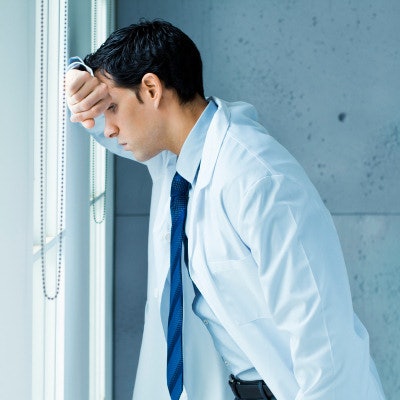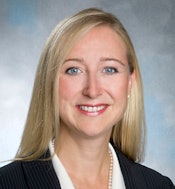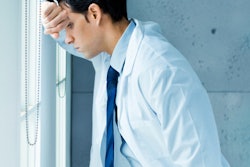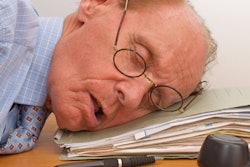
In a new survey, more than one-third of New England radiology residents said they have a high degree of burnout and feel that the condition increases with each postgraduate year of training, according to a study in the July issue of the American Journal of Roentgenology.
In addition, the New Englanders most often cited a feeling of low personal achievement because of burnout, followed by emotional exhaustion and high depersonalization. The findings surprised the researchers, who are from Brigham and Women's Hospital in Boston.
"Finding out that burnout is increasing with each year was something we had not expected, but it makes sense in that they are given more responsibilities as they get further along in their training," said study co-author Dr. Stacy Smith, associate residency program director at the hospital. "But it was this [sense] of low personal accomplishment that was very intriguing."
Addressing burnout
Previous research has documented how burnout in any job can lead to decreased productivity and commitment, as well as a deteriorating home life. These issues can eventually have clinical manifestations, such as cardiovascular disease, metabolic syndrome, systemic inflammation, and impaired immunity.
 Dr. Stacy Smith from Brigham and Women's Hospital.
Dr. Stacy Smith from Brigham and Women's Hospital.The burnout issue was brought to the fore for Smith at last year's American Roentgen Ray Society (ARRS) annual meeting in the keynote address by then-ARRS President Dr. Mauricio Castillo, chief of the division of neuroradiology at the University of North Carolina (UNC). In his talk, Castillo recounted a study that reported feelings of burnout in 80% of UNC radiology residents and in nearly 90% of general surgery interns. In addition, 17% of all UNC residents thought they were depressed (InPractice, Spring 2016, Vol. 10:2, p. 2).
The specific effects of burnout in radiologists, however, had not been investigated in great depth, wrote Smith and study co-author Dr. Jeffrey Guenette, chief radiologist at Brigham and Women's, in the current study (AJR, July 2017, Vol. 209:1, pp. 136-141).
"Oftentimes, we don't know that it is burnout. Someone may not be performing as well; they may seem uninterested or feel like they are overloaded [with work], and there are a lot of scenarios to go with that," Smith told AuntMinnie.com. "We see an increase in demand on physicians. We see the medical economic system changing, and hospitals have to operate more like businesses in many respects. So we wanted to see, what is the state of affairs where we live?"
When the Brigham and Women survey commenced, there were 472 radiology residents at 20 accredited programs in New England. The researchers emailed a link to the survey to all residency program directors and coordinators, along with a request to forward the communiqué to all program residents. The survey was open for three weeks from April to May 2016.
The questionnaire included five demographic questions, four residency program-related questions, and 22 items from the Maslach Burnout Inventory - Human Services Survey (MBI-HSS). The MBI-HSS measures and validates three components of burnout: emotional exhaustion, depersonalization, and personal accomplishment. It defines a high degree of burnout as a score of greater than 26 for emotional exhaustion, a score of greater than 10 for depersonalization, and a score of less than 33 for personal achievement.
Survey says ...
A total of 94 (20%) surveys were returned. First-year residents returned the most surveys (31 replies, 33%), followed by fourth-year residents (26, 28%), second-year residents (19, 20%), and third-year residents (18, 19%).
Most of the surveyed residents (41 replies, 44%) were 30 to 32 years old, followed by those 27 to 29 years of age (29, 31%). The greatest number of residents averaged 51 to 55 clinical hours per week (34, 36%), while 37 residents (39%) averaged five to eight study hours per week.
In seeking to identify which factors were most likely to predict burnout, the researchers focused most on the number of residency years, gender, and relationship status. Of the three, residency year was the only factor that predicted burnout on a statistically significant basis. Residency year also contributed to high levels of emotional exhaustion and depersonalization.
The findings coincide with radiology residents having more responsibilities as they advance with their training. However, the numbers may also indicate a new trend.
"My experience in the 1990s was students tended to have burnout in their first year of training because they were away from patient care," Smith recalled. "Then, as they go further, they realize there is patient care and more activity in radiology. It was really this wonderful, three-dimensional type of practice. Then the burnout tended to decrease."
As for the residual effects of burnout, low personal achievement (50%) was cited most often, followed by high depersonalization (48%) and high emotional exhaustion (37%).
| Impact of burnout on emotional health of residents | |||
| Degree of burnout | |||
| Low | Moderate | High | |
| Emotional exhaustion | 37% | 26% | 37% |
| Depersonalization | 23% | 29% | 48% |
| Low personal achievement | 20% | 30% | 50% |
The finding that 50% of respondents ranked personal achievement as their highest challenge from burnout was "an eye-opener," Smith said.
"We tend to think that residents are taking on more responsibility," she added. "In radiology they are asked to read so much more; there are so many new technologies that are coming out, and they have to keep abreast of all of that on top of the medical information they have learned in medical school and radiology residency."
But today's radiology residents also have more oversight by training physicians, compared to when Smith was in training. For three months as a fourth-year resident, she was considered faculty and made final decisions on studies.
"We don't have that in our residencies here, so they are constantly having someone else make a lot of those decisions," she said. "I think they are asked to do a lot of other things as well over which they may not have as much autonomy, and are asked to respond to someone else or report to someone else."
The radiology residents who rated personal achievement low on their burnout chart tended to "moonlight, so they had more autonomy when moonlighting after-hours," Smith said. "They then feel like they are accomplishing something themselves."
Call to action
Given that radiology residents expressed so many issues with personal achievement, solving that problem could go a long way toward improving burnout symptoms overall, according to the authors.
"When we got the [study] results, we realized we have many resources here for residents in terms of providing education, mentorship, and professional feedback," Smith said. "Whether or not they use them, we have not looked at that to a scientific study extent."
Smith is a member of the executive council for the New England Roentgen Ray Society, which provides education and guidance for residents in the region. She said it's always interesting to listen to the radiology residents talk about "how much they have on their plate" and what they are asked to do.
To address burnout at Brigham and Women's, the hospital recently completed its first hospital-wide wellness survey in all departments. In addition, it promotes teambuilding, communication, and fitness to lessen the potential for burnout. Several departments, including radiology, have created their own wellness committees. There is also a Fitbit challenge at the Boston Athletic Association 10K run, through which trainees and faculty are encouraged to walk and exercise more.
Smith and Guenette are currently conducting a national survey based on this pilot study to gauge burnout among radiology residents across the U.S.
"We hope to do a further investigation and follow up on our New England residents as well," Smith said. "We are hoping to find ways that we can alleviate this [issue] before it is too far gone. I think it is very important work."



















